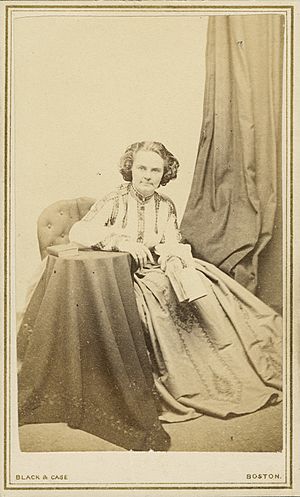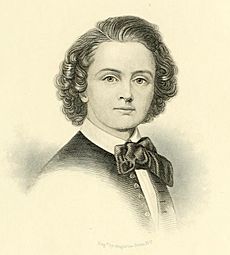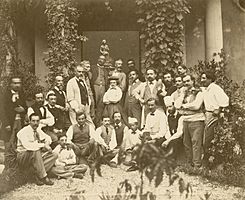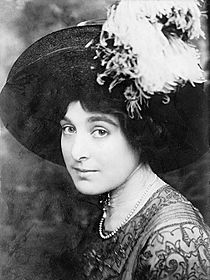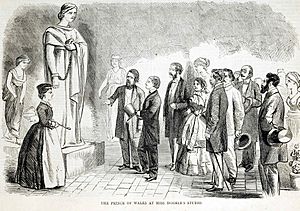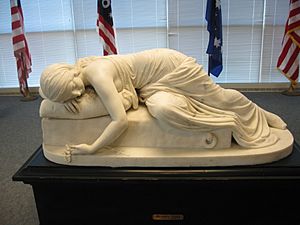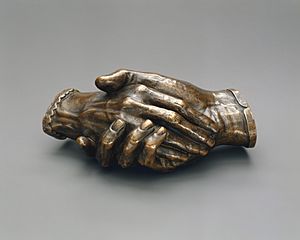Harriet Hosmer facts for kids
Quick facts for kids
Harriet Hosmer
|
|
|---|---|
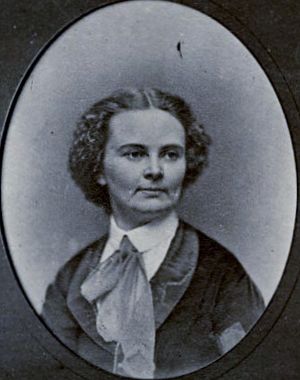 |
|
| Born | October 9, 1830 |
| Died | February 21, 1908 (aged 77) Watertown, Massachusetts
|
| Nationality | American |
| Known for | Painting, Sculpture |
| Movement | Neoclassicism |
| Partner(s) | Louisa Baring |
| Signature | |
Harriet Goodhue Hosmer (born October 9, 1830 – died February 21, 1908) was a famous American sculptor. She worked in a style called Neoclassicism, which was popular in the 1800s. Many people thought she was the most important female sculptor in America during her time. She is also known as the first professional female sculptor.
Harriet Hosmer invented new ways to create her art. For example, she found a way to change regular limestone into marble. She lived in Rome, Italy, for many years, where she became friends with famous writers and artists.
She was a cousin of the poet William H. C. Hosmer and the actress Jean Hosmer.
Contents
About Harriet Hosmer's Life
Her Early Life and Learning
Harriet Hosmer was born on October 9, 1830, in Watertown, Massachusetts. She went to the Sedgewick School in Lenox, Massachusetts. Sadly, her mother and three brothers and sisters died when Harriet was young.
She was a delicate child, so her father, Dr. Hiram Hosmer, encouraged her to be very active. She became good at rowing, skating, and riding horses. Her father also supported her love for art. She even traveled alone through the western United States and visited the Dakota Indians.
Harriet showed a talent for sculpting very early on. She studied how the human body works with her father. Later, a family friend, Wayman Crow, helped her study anatomy at the Missouri Medical College. She then practiced sculpting at home in Boston.
In 1852, she moved to Rome, Italy, with her father. From 1853 to 1860, she learned from a Welsh sculptor named John Gibson. In Rome, she was finally allowed to study real people as models for her sculptures.
When Hosmer knew herself to be a sculptor, she knew also that in America was no school for her. She must leave home, she must live where art could live. She might model her busts in clay of her own soil, but who should follow out in marble the delicate thought which the clay expressed? The workmen of Massachusetts tended the looms, built the railroads, and read the newspapers. The hard-handed men of Italy worked in marble from the designs put before them; one copied the leaves which the sculptor threw into the wreaths around the brows of his heroes; another turned with the tool the folds of the drapery; another wrought up the delicate tissues of the flesh; none of them dreamed of ideas - they were copyists - the very hand-work that her head needed. And to Italy she went...
Life in Rome
While living in Rome, Harriet was part of a group of artists and writers. This group included famous people like Nathaniel Hawthorne, Bertel Thorvaldsen, William Makepeace Thackeray, and the philosopher Frances Power Cobbe. When she visited Florence, she often stayed with the poets Elizabeth Barrett and Robert Browning.
She was very peculiar, but she seemed to be her actual self, and nothing affected or made up; so that, for my part, I gave her full leave to wear what may suit her best, and to behave as her inner woman prompts.
Many American female sculptors lived in Rome at this time. They included Anne Whitney, Emma Stebbins, Edmonia Lewis, Louisa Lander, Margaret Foley, Florence Freeman, and Vinnie Ream. The writer Nathaniel Hawthorne wrote about them in his novel The Marble Faun. Harriet Hosmer is seen as the leader of this group of talented women sculptors. Frances Power Cobbe believed that Harriet's success showed that women could be just as creative and artistic as men.
Her Artistic Style
Harriet Hosmer loved the Neoclassical style of art. It was easy to study this style because she lived in Rome, where there were many ancient Roman and Greek artworks. She enjoyed learning about mythology. She created many sculptures of mythological figures, like The Sleeping Faun. This sculpture shows amazing details in the hair, grapes, and cloth.
Later Years and Achievements
Harriet Hosmer also designed and built machines. She created new ways to make sculptures. One method allowed her to turn common Italian limestone into marble. Another process involved making a rough shape of a statue in plaster, then adding a layer of wax to create the finer details.
Later in her life, Hosmer lived in Chicago and Terre Haute, Indiana.
She showed her sculpture of Queen Isabella at the 1893 World's Columbian Exposition in Chicago. This statue was ordered by the Queen Isabella Association. It was also shown again in 1894 at the California Midwinter International Exposition.
Harriet Hosmer died in Watertown, Massachusetts, on February 21, 1908. She is buried in her family's plot at Mount Auburn Cemetery, Cambridge. Harriet Hosmer made a big impact on art history. The National Museum of Women in the Arts said that "Harriet Goodhue Hosmer defied 19th-century social convention by becoming a successful sculptor of large scale, Neoclassical works in marble." This means she broke the rules of her time by becoming a successful female sculptor.
Women in Art During the 1800s
In the 1800s, it was unusual for women to have careers, especially as sculptors. Women were not allowed to get the same art education as men. They were not trained to create "great" art, like large paintings of history or mythological scenes, or to sculpt human figures.
Women usually made art they could do at home. This included still life paintings, portraits, landscapes, and small carvings. Even Queen Victoria allowed her daughter, Princess Louise, to study sculpture.
Harriet Hosmer was not allowed to attend regular art classes because working with live models was forbidden for women. But she took anatomy classes to learn about the human body. She also paid for private sculpture lessons. Her biggest career step was moving to Rome to study art. Harriet owned her own studio and ran her own business. She became a well-known artist in Rome and received many orders for her sculptures.
Harriet Hosmer spoke about breaking from tradition. She said, "I honor every woman who has strength enough to step outside the beaten path when she feels that her walk lies in another; strength enough to stand up and be laughed at, if necessary."
Harriet Hosmer's Legacy
Mount Hosmer, a hill near Lansing, Iowa, is named after Harriet Hosmer. She won a footrace to the top of the hill during a steamboat stop in the 1850s.
During World War II, a Liberty ship called SS Harriet Hosmer was built in Panama City, Florida, and named in her honor.
A book of poems about her life, Waking Stone: Inventions on the Life Of Harriet Hosmer, was published in 2006.
Her sculpture, Puck and Owl, is featured on the Boston Women's Heritage Trail.
The Hosmer School in Watertown, Massachusetts, is a public elementary school. It was built on land given by Harriet's father, Dr. Hiram Hosmer. The school was first named after her father and her cousin, Dr. Alfred Hosmer. On February 1, 2022, the town renamed the school to include Harriet. This was to recognize her as an internationally famous artist, even though women had fewer chances for public achievements in her time.
Selected Artworks
Harriet Hosmer made both large and small sculptures. She also created works for specific orders. Her smaller pieces were often made many times because they were so popular. One of her most famous works was 'Beatrice Cenci', which exists in several versions.
- Hesper, The Evening Star, her first original sculpture (1852)
- Doctor McDowell, a portrait of a man who helped her career (1852)
- Clasped Hands of Robert and Elizabeth Barrett Browning (1853)
- Daphne and Medusa, ideal heads (1853)
- Puck (1855), a lively and graceful sculpture that she copied for royalty and others
- Oenone (1855), her first life-sized figure, now in the Saint Louis Art Museum
- Will-O-The-Wisp, with three known versions (1856, 1858, 1864)
- Beatrice Cenci (1857), found in several places, including the St. Louis Mercantile Library
- Zenobia, Queen of Palmyra (1857), at the Art Institute of Chicago
- Lady Constance Talbot, a rare portrait of a woman (1857)
- Tomb of Judith Faconnet, the first American artwork permanently in Sant'Andrea della Fratte (1857 - 1858)
- The Fountain of the Hylas and the Water Nymphs (1858)
- Zenobia (1859), owned by the Saint Louis Art Museum in St. Louis, Missouri
- The Fountain of the Siren, her most famous fountain design (1861)
- Thomas Hart Benton, the first public monument in Missouri (1862)
- Gate for an Art Gallery (1864)
- A Sleeping Faun (1865) is now at the Museum of Fine Arts, Boston.
- Portrait of Wayman Crow (1866), John Gibson (1866)
- A Waking Faun; a bronze statue of Thomas H. Benton (1866 - 1867) for Lafayette Park, St. Louis. It was a partner piece to "The Sleeping Faun".
- Lincoln Memorial, also called "Freedmen's Monument" (1867 - 1868)
- Queen of Naples, the second of three full-size statues of famous queens Hosmer made (1868)
- Sentinel of Pompeii (1878)
- Crerar Lincoln Memorial - The African Sibyl, made for a Lincoln Memorial competition (1888 - 1896)
- Bronze gates for the Earl of Brownlow's art gallery at Ashridge Hall.
- The Staghound, ordered by the Empress of Austria
- Dolphin Fountain (1892), the male partner to Hosmer's The Mermaid's Cradle, her only complete fountain left (1892 - 1893)
- Queen Isabella of Castile, Hosmer's last known finished work, ordered by the Daughters of Isabella (1893)
- An alternate Emancipation Memorial—designed but not built
- Statues of the queen of Naples and Queen Isabella of Spain for the Columbian Exposition, Chicago, 1893.
Gallery
-
Zenobia, Queen of Palmyra, 1857, Art Institute of Chicago
See also
 In Spanish: Harriet Hosmer para niños
In Spanish: Harriet Hosmer para niños


